We set off from Opua, NZ, on Wednesday, April 18th, 2018. Before leaving the Bay of Islands, we raised the mainsail and unfurled the genoa. It was a lovely day in the bay.
A couple other boats checked out of Opua on the same morning. Bright Angel, a Vancouver boat, was going to Tahiti and the other, with French crew, we never saw again.
Being very early in the cruising season, it was “quiet” offshore with no other yachts around. After leaving the Bay of Islands, we encountered just three cargo ships and two fishing boats.
We filed a Trip Report by email with Peter at Northland Radio and checked in with him by SSB every evening. It was nice to know someone knew where we were and what conditions we were reporting. We also posted daily with www.yit.nz but Gulf Harbour Radio (SSB 8752 at 1915 UTC) was not active until May 1st. We talked to our sister boats by SSB a few times, but it was generally easier to email or text them using our Iridium Go (satellite) connection.
We did notice a great improvement in the Iridium satellite coverage compared to previous years. We were told that more satellites had been launched and they seemed to make a difference! We hardly ever dropped a connection for emailing or downloading weather. Trying to make calls using the Iridium was still useless as the party on the other side could not hear us, despite showing 5 bars (the max signal).
The seas were confused for several days as we gradually cleared the blocking influence of the North Island of NZ. “Lumpy” was how we described it! Basic day-to-day activities, like taking a shower, took serious planning.
Lucky for me, Monty had prepared some great one-pot meals before we left and was willing to go below (to our galley), cook and do dishes during the boisterous conditions. Even on a catamaran, we have to take care moving around. “One hand on the boat” is the rule when it gets rough. Regardless, Monty was always ready with the barista-style cafe latte and a smile at daybreak.
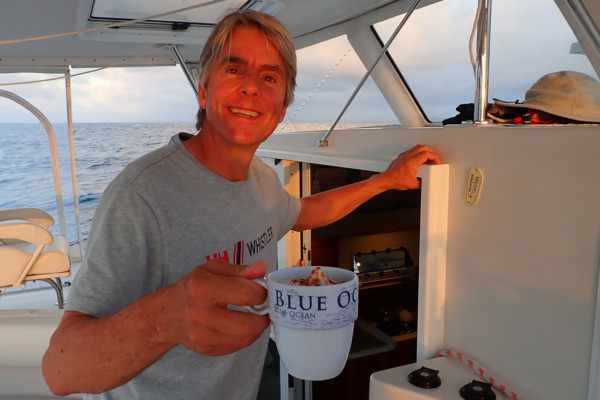
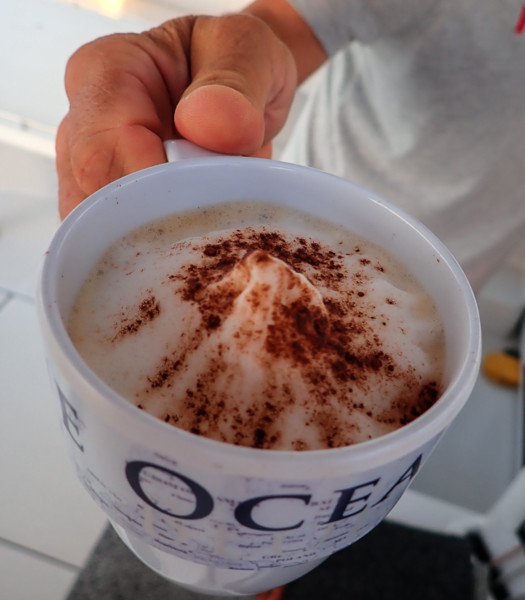
The moon didn’t rise until well into the night, so the star-gazing was epic. It was hard to sit outside safely in 20 knots with a fairly boisterous sea but, every once in a while, I would sit on the back edge of the cockpit cushion, holding onto a support beam, and look up for a few minutes. I used the SkyView Lite app on my iPad to identify the stars and constellations. Mars, Saturn, Jupiter and occasionally Venus and Mercury were visible. The Milky Way and Southern Cross are always very easy to pick out. Imagining how sailors used just the sun and stars to navigate is pretty amazing to us with all our modern gadgetry.
It seemed early to see humpback whales but we saw a pod of at least three. One albatross, several boobies and black petrels were spotted, with more activity closer to the Kermadec Islands. Days apart, a swallow tried to take refuge in our cockpit and even darted into our salon a few times. Both times, the bird disappeared, flying away at high speed just above the surface. We wondered if it had been a stowaway from NZ, if it was the same bird or if two different birds had just come upon us hoping for a rest spot. It is a mystery to us where the cute little birds flew off to, as we were hundreds of miles from any land.
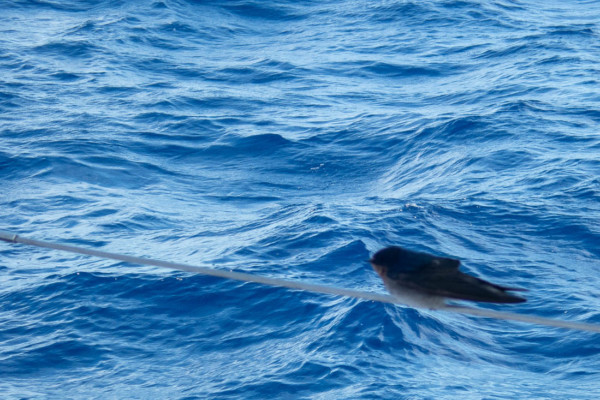
Welcome swallow hanging onto our lifeline
We are frequently amazed at the currents we encounter out in the open ocean. After the passage, we compared our speedo’s mileage to our GPS tracker (InReach) and found them to be very close, so those currents are not our imagination. On our chartplotter below, you can see a 1kt current with a direction of 185 degrees, almost opposite to our heading of 19 degrees. Currents can greatly impact our boat speed. We are thankful when they are in our favour, but we notice them more when they are against us!
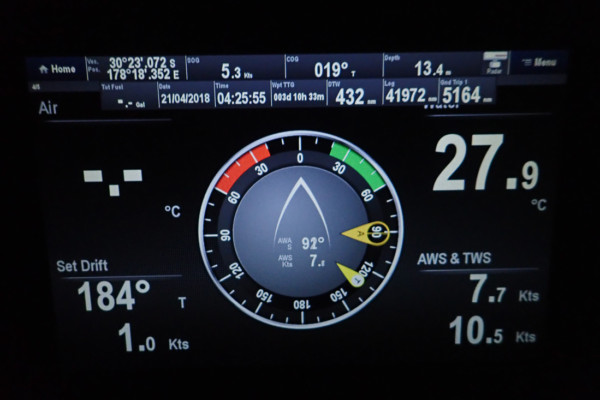
Set Drift in lower left corner
Monty pointed out this unusual rainbow just above the horizon one the morning.
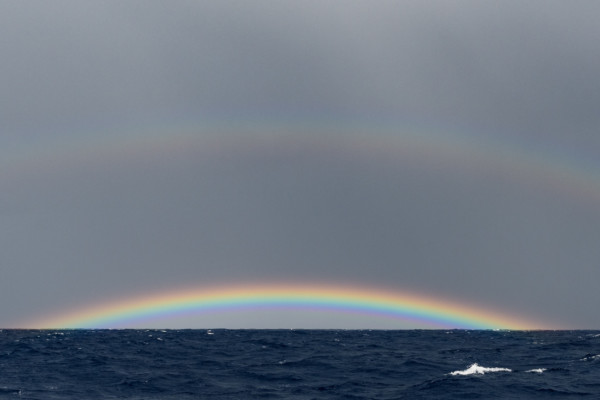
We had watch out for some squalls particularly in the late afternoon and evening, a typical pattern in this tropical part of the world. The wind speeds and direction can change dramatically making it important to be attentive and vigilant at the helm. Sometimes we could completely avoid a dousing by turning 10 or 20 degrees for an hour.
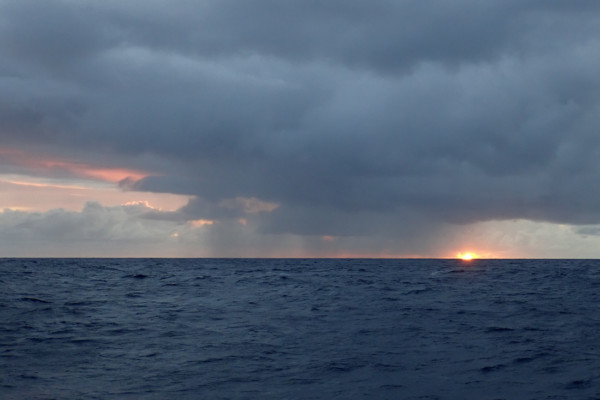

Identifying and avoiding squalls using radar
We always try to be in the cockpit to enjoy the sunsets and sunrises. A good one can give the spirits a boost. It reminds me of a scene in the City of Angels movie.
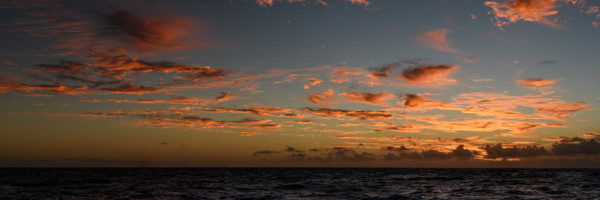
I was able to capture another “Green Flash”. The photos below were taken, underexposing by a few stops, so the Green Flash would not be blown out. Hopefully you can see the green tinge as the sun disappears.
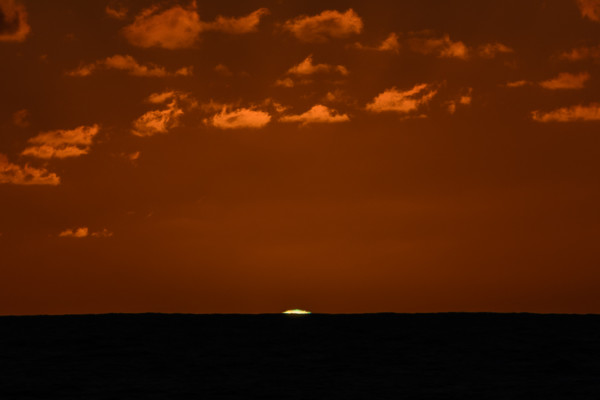
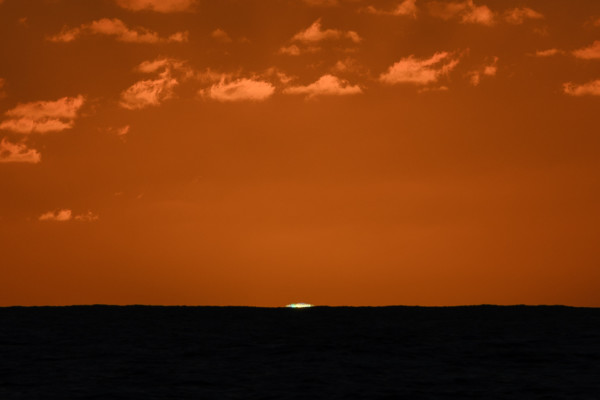
Our original plan was to sail to Minerva Reef and meet up to our sister boats, Exit Strategy and Golden Glow. They had left on the Saturday before and had anchored at North Minerva for about 5 days. They had to sit out stormy conditions for about 3 days at the reef, not even leaving their boats. They managed to get in some exploring by dinghy when the weather cleared up. Understandably, they decided to leave for Fiji with the onset of favourable conditions for that leg.
We debated whether to stop at North Minerva Reef or carry on. Being there alone was not very appealing, given the time of year. We had made great time on the previous couple of days, almost too good, which meant our arrival at the reef would have been at dusk, an unsafe time to negotiate the entrance. We would have had to heave-to all night in strong winds and considerable swell, awaiting daylight. The weather forecast for Minerva for the next few days was not great. If we stopped, it appeared we would have to wait several days, maybe more than a week, for some helpful winds to sail north to Fiji. For those reasons, we decided to skip Minerva this time and take advantage of the good wind direction and speed propelling us toward Fiji.
We looked at whether to head to Port Denarau or Savusavu. Port Denarau was reporting they were very busy and it was not clear how long they could accommodate us on the dock. In mid-2017, the marina had received permission from Customs to clear boats in and it seemed it was impacting business. They said they were fully booked from May 1st to the end of October and we would have to go on a wait list if we arrived later than April 30th. The wind conditions were ideal for Savusavu (on the beam), and our sister boats were heading to there, so Savusavu was the call. We emailed Fiji Customs and the marina in Savusavu to advise them we were coming.
For the latter three days of the passage, the waves were decidedly on the beam and fairly short period, making it a bit noisy and more than a tad uncomfortable. The sea state finally settled down a bit when the Lau Islands started giving us some protection from the east.
Monty put the fishing lines out when it was calm enough that he could envision cleaning a fish on the back steps. Something took a chunk out of one lure, but nothing bit hard. Were we going too slowly, did we have the wrong lures out or is a sign of the health of the Fiji waters? There are many factors that can impact fishing outcomes!
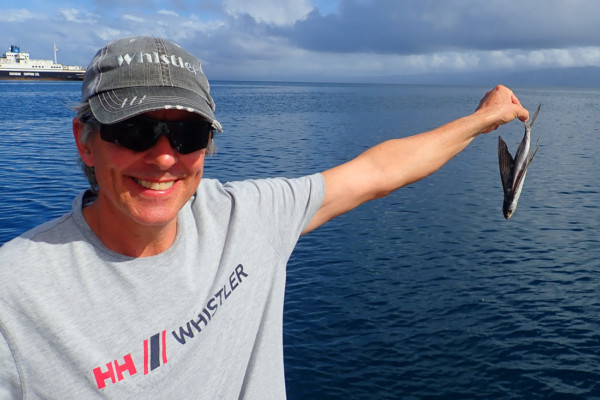
An unfortunate flying fish washed up on our deck. “Very stinky”, Monty reported.
As we approached Koro Island, 30 miles south of Savusavu, the boat got a thorough powerwash as we sailed through a big squall. I was dead asleep but Monty said it was quite the downpour. It was nice to get the salt washed off and arrive in port with a clean boat, at least outside!
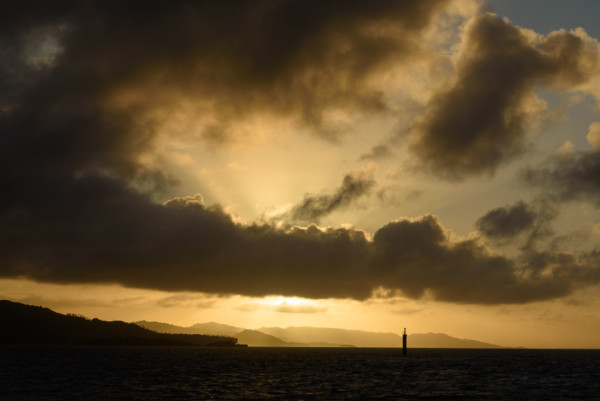
Entering Savusavu Bay by the Jean-Michel Cousteau Resort Fiji
We tied up at a Waitui Marina mooring in Savusavu around 8am on April 26th. Arriving in Savusavu felt quite familiar, like stopping at Merlin’s for lunch. (Our Whistler friends know what I mean.) Our sister boats arrived the night before, so we had good company.
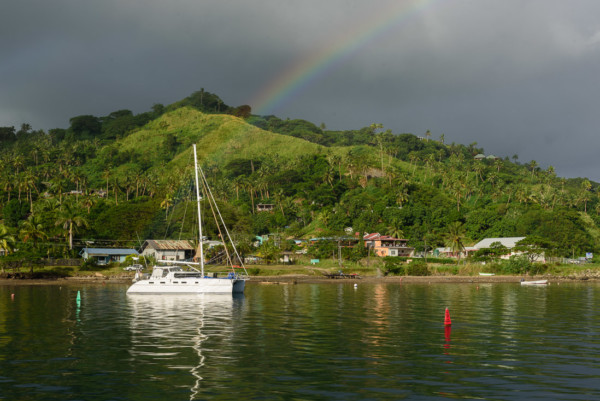
Sister boat, Golden Glow, across the harbour from our mooring
The Health Dept visited us first, to ensure we were not bringing any diseases or pests into the country. Then Customs, Bio-security and Immigration came aboard to finish the process of clearing us into Fiji. It was all done by mid-morning.
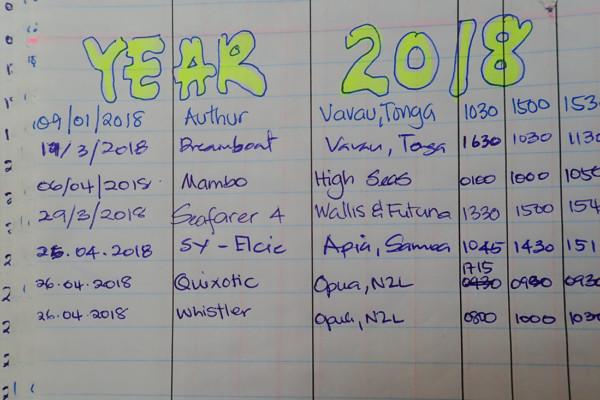
Fiji Custom’s scribbler notes showing our arrival as the 7th yacht to clear into Savusavu in 2018
Monty got the dinghy in the water and, in the afternoon, we went around town to pay fees to the various agencies. We also stopped by the market to pick up the three P’s, (papayas, passionfruit and pineapples). A yummy tropical fruit salad for breakfast tomorrow!
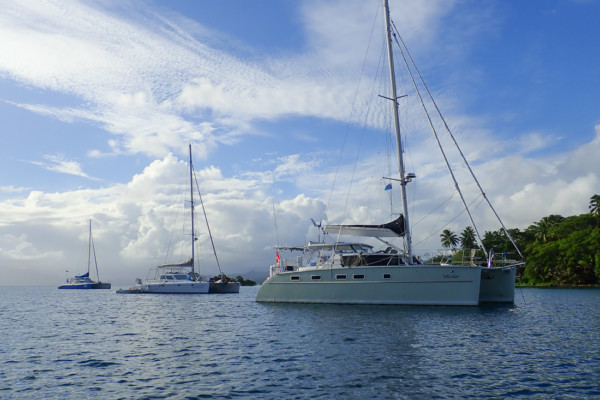
Whistler on a mooring in Savusavu
To summarize our sailing, we gybed the mainsail once to correct our course northward after leaving the Bay of Islands, and once to avoid a fishing boat but a full main was up for the entire passage. We sailed with our Code Zero during the daytime when the winds were not too strong but we furled it in the late afternoons and evenings as the winds often accelerate and squalls develop. The majority of the time, we used our genoa. We do like our Willis Sails!

As for engine time, early on in the passage, we had to cross a ridge axis (the centre of a High), so we ran one engine to assist our sails for about 40 hours. The fuel tanks were almost full when we arrived in Fiji so no fuss about having to refuel immediately, which has to be done by jerry cans in Savusavu.
The trip was 1266 miles and took just 4 hours shy of 8 days. Nothing major broke, another sign of a good passage to us. We were looking forward to catching up with our friends on Exit Strategy and Golden Glow and, then, a good 8 hours of uninterrupted sleep!
Thanks to Bruce Buckley, our weather router, for helping us to pick a good window and to David and Patricia at Gulf Harbour Radio (www.yit.nz). A special thanks goes to our family and friends for their support and to “Whistler” for another safe passage from New Zealand!

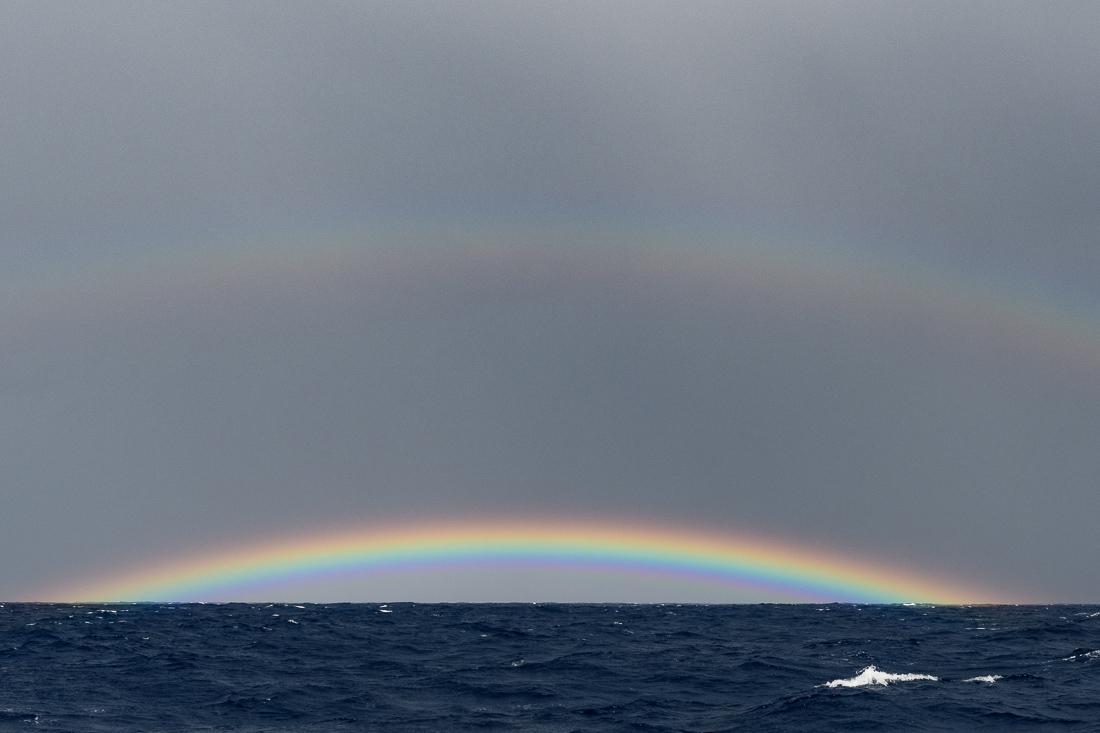
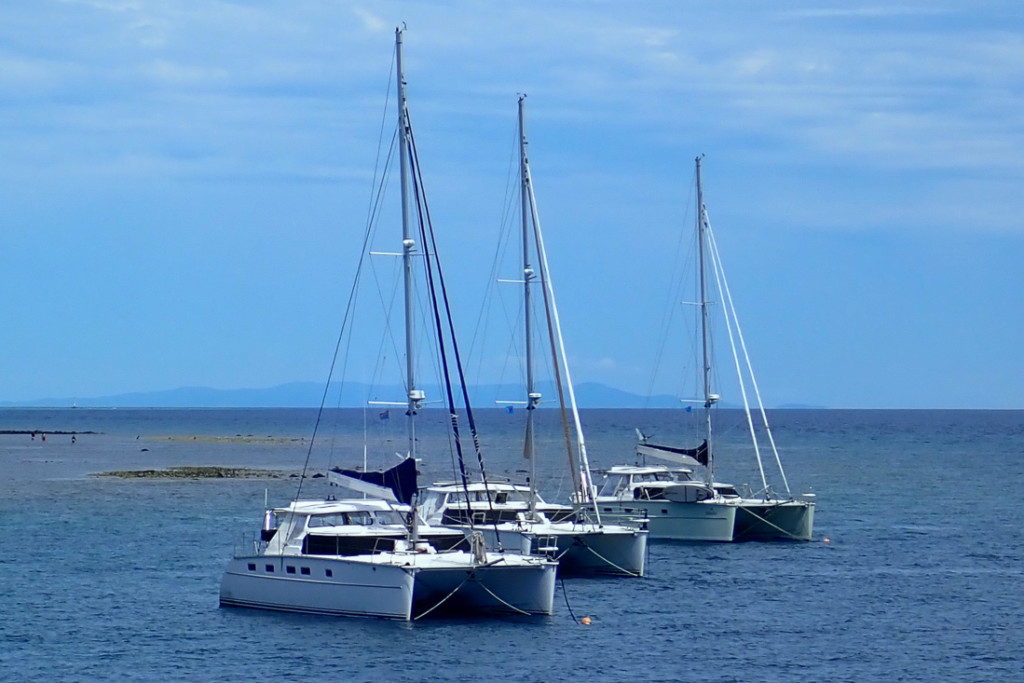
19 comments
Great writing job on the blog. Almost felt like we were there.
NIce capture on the green flash.
Thanks, Payson. Hope you are enjoying retirement! Sounds like you are getting in some golf and planning a few little trips.
Congratulations! Well done! What a great passage- enjoy your fiji time!
Thanks, Christian! We recently took out the beige side mesh curtains for the enclosure and may give them a try here in Fiji! Hope all is well in Tuscany!
Nice hair cut – looking very business like 🙂
Look forward to seeing you soon
XX
Glad he cut his hair. Not as much long hair around the boat now!
Amazing description of your spectacular journey. Such skill & stamina!
Enjoy some R & R
Thanks for sharing.
D
Great to get a thorough update on your passage. Merlins or the Handle Bar? Good to see you finally got some healthy sized Latte mugs! Love your rainbow photo Margy. Must be lovely to be so comfortable in familar waters.
Happy kiting…
Carol
Thanks, Carol! Nice to hear from you! We will post another one soon. Hugs, M&M
Thank you Margy for a wonderful blog all’s well here with dad looking forward to conversing with you soon
David arriving this evening for a week take care of yourselves. Love dad
Thanks, Dad, and nice to see you commenting on the site! Love you and David! Enjoy your visits!
Glad you arrived safely. Have fun!
Thanks, Lois. Hope all is well with your little grandson, James and love to all your family!
Great account of some arduous sailing days and beautiful photos as always. Love the new look on Monty…and his super-size latte’s! Take care you too. Enjoy some rest.
Thanks for your note, Holly! Hope you are having lots of fun and success golfing!
What does Monty use to whip his lattes? Photos are great as always. We were talking about you guys the other day, as we are staying with friends who are from Calgary. Lots of up north talk. 🙂
Hi, Amy and David! Long time! Monty uses a battery operated foaming wand made for foaming milk. We put the milk in a S/S milk jug like we use for the cappuccino machine, and heat in on the stove to 160 degrees. Start foaming around 140 degrees. The device should be easy to find on line. Hugs! M&M
Hey Guys.. We are now vicarious cruisers and have just subscribed to your blog to keep our fixes coming. Panthera should be sold by the end of the week :(. We are back here in Whistler ( had some great Spring skiing the last 2 days) . Hope you have a great cruising/kiting season. Keep the stories and photo coming.
Jane & Ritchie
Hi
Congrats on the trip
We’re heading Australia to NZ and I was hoping to get a contact for Bruce Buckley to due the weather routing
Cheers
Tim Wood